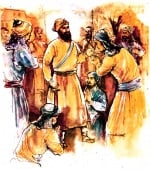Template:AOW15: Difference between revisions
Hari singh (talk | contribs) No edit summary |
Hari singh (talk | contribs) No edit summary |
||
| (One intermediate revision by the same user not shown) | |||
| Line 1: | Line 1: | ||
{{ | {{Aowh2|Sahibzada Ajit Singh|Sahibzada Ajit Singh|birthday February 11}} | ||
{{pm|Image:Baba ajit singh.jpg|<small>'''[[Sahibzada Ajit Singh]] asking for blessings from his father, [[Guru Gobind Singh]]'''</small>}} | |||
'''[[Sahibzada Ajit Singh]]''' (1687 - 1705), the eldest of four sons of [[Guru Gobind Singh]], was born to [[Mata Jito]] ji (also known as [[Mata Sundari]] ji) at [[Paonta sahib]] on | '''[[Sahibzada Ajit Singh]]''' ([[11 February]] [[1687]] - [[7 December]] [[1705]]), the eldest of four sons of [[Guru Gobind Singh]], was born to [[Mata Jito]] ji (also known as [[Mata Sundari]] ji) at [[Paonta sahib]] on [[11 February]] [[1687]]. The following year, [[Guru Gobind Singh]] returned with the family to [[Anandpur sahib]] where [[Ajit Singh]] was brought up in the approved Sikh style. | ||
He was taught the religious texts, philosophy and history, and had training in the martial arts such as riding, swordsmanship, [[gatka]] and archery. He grew up to be a handsome young man, strong, intelligent and a natural leader of people. Soon after the creation of the [[Khalsa]] on 30 March 1699, he had his first test of skill. A group of Sikhs ([[sangat]]) coming from Pothohar, northwest [[Punjab]], was attacked and looted on the way by the Ranghars of Nuh, a short distance from [[Anandpur]] across the [[River Sutlej]]. | He was taught the religious texts, philosophy and history, and had training in the martial arts such as riding, swordsmanship, [[gatka]] and archery. He grew up to be a handsome young man, strong, intelligent and a natural leader of people. Soon after the creation of the [[Khalsa]] on 30 March 1699, he had his first test of skill. A group of Sikhs ([[sangat]]) coming from Pothohar, northwest [[Punjab]], was attacked and looted on the way by the Ranghars of Nuh, a short distance from [[Anandpur]] across the [[River Sutlej]]. | ||
[[Guru Gobind Singh]] sent [[Sahibzada Ajit Singh]], barely 12 years of age then, to that village to intervene, defend the sangat and deal with the intruders. Ajit Singh at the head of 100 Sikhs reached there on 23 May 1699, punished the Ranghars and recovered the looted property. Following this successful mission, a much harder task was entrusted to him the following year when the hill chiefs supported by imperial troops attacked [[Anandpur]]. | [[Guru Gobind Singh]] sent [[Sahibzada Ajit Singh]], barely 12 years of age then, to that village to intervene, defend the sangat and deal with the intruders. Ajit Singh at the head of 100 Sikhs reached there on '''23 May 1699''', punished the Ranghars and recovered the looted property.<!-- Following this successful mission, a much harder task was entrusted to him the following year when the hill chiefs supported by imperial troops attacked [[Anandpur]]. Sahibzada Ajit Singh was made responsible for the defence of Taragarh Fort which became the first target of attack.---> {{Aowf|Sahibzada Ajit Singh}} | ||
Latest revision as of 18:41, 31 January 2010

Sahibzada Ajit Singh (11 February 1687 - 7 December 1705), the eldest of four sons of Guru Gobind Singh, was born to Mata Jito ji (also known as Mata Sundari ji) at Paonta sahib on 11 February 1687. The following year, Guru Gobind Singh returned with the family to Anandpur sahib where Ajit Singh was brought up in the approved Sikh style.
He was taught the religious texts, philosophy and history, and had training in the martial arts such as riding, swordsmanship, gatka and archery. He grew up to be a handsome young man, strong, intelligent and a natural leader of people. Soon after the creation of the Khalsa on 30 March 1699, he had his first test of skill. A group of Sikhs (sangat) coming from Pothohar, northwest Punjab, was attacked and looted on the way by the Ranghars of Nuh, a short distance from Anandpur across the River Sutlej.
Guru Gobind Singh sent Sahibzada Ajit Singh, barely 12 years of age then, to that village to intervene, defend the sangat and deal with the intruders. Ajit Singh at the head of 100 Sikhs reached there on 23 May 1699, punished the Ranghars and recovered the looted property. .....More
